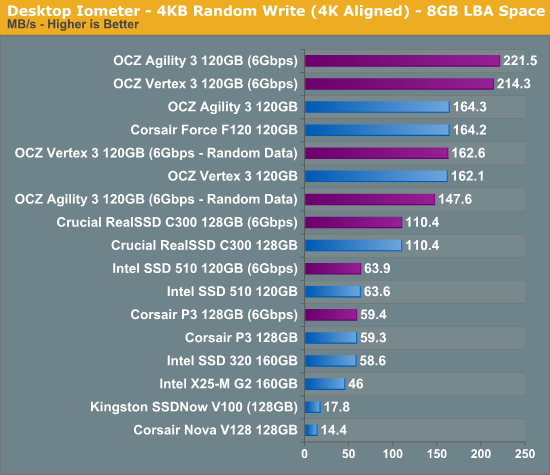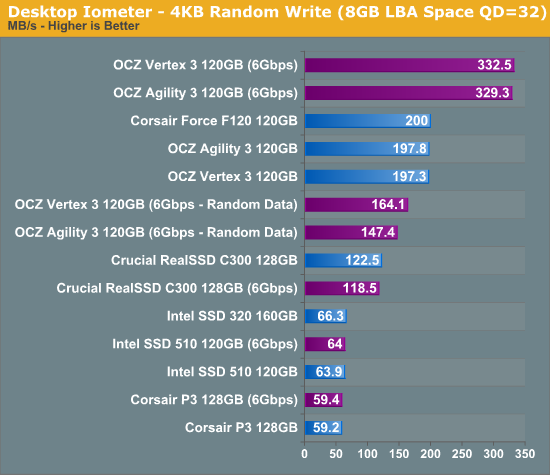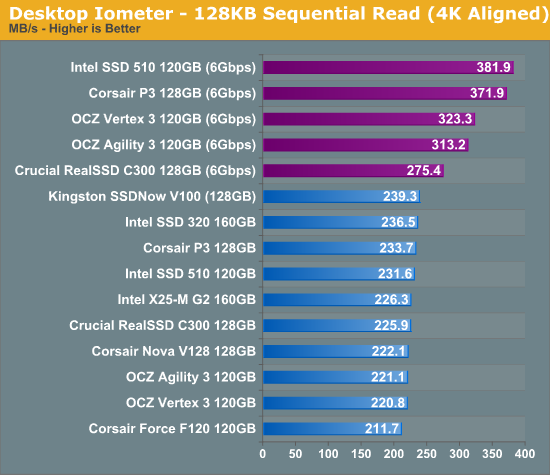The 2011 Mid-Range SSD Roundup: 120GB Agility 3, Intel 510 and More Compared
by Anand Lal Shimpi on June 7, 2011 12:52 PM ESTRandom Read/Write Speed
The four corners of SSD performance are as follows: random read, random write, sequential read and sequential write speed. Random accesses are generally small in size, while sequential accesses tend to be larger and thus we have the four Iometer tests we use in all of our reviews.
Our first test writes 4KB in a completely random pattern over an 8GB space of the drive to simulate the sort of random access that you'd see on an OS drive (even this is more stressful than a normal desktop user would see). I perform three concurrent IOs and run the test for 3 minutes. The results reported are in average MB/s over the entire time. We use both standard pseudo randomly generated data for each write as well as fully random data to show you both the maximum and minimum performance offered by SandForce based drives in these tests. The average performance of SF drives will likely be somewhere in between the two values for each drive you see in the graphs. For an understanding of why this matters, read our original SandForce article.

At worst, SandForce's small file random write performance is equal to its closest competitors, but at best it is significantly greater. Both the Vertex 3 and Agility 3 take the cake here. The Marvell based solutions are significantly slower, however we'll see if that matters in the real world tests.
Many of you have asked for random write performance at higher queue depths. What I have below is our 4KB random write test performed at a queue depth of 32 instead of 3. While the vast majority of desktop usage models experience queue depths of 0 - 5, higher depths are possible in heavy I/O (and multi-user) workloads:

At higher queue depths the advantage just grows for the SF-2281 drives.

Crucial optimized very heavily for random read performance, and to this day nothing (even the replacement m4/C400) can outperform the C300 in our small file random read test. Intel's SSD 510 is the next fastest 6Gbps drive we've got here, followed by the P3 and eventually the Vertex 3/Agility 3.
Sequential Read/Write Speed
To measure sequential performance I ran a 1 minute long 128KB sequential test over the entire span of the drive at a queue depth of 1. The results reported are in average MB/s over the entire test length.

To post high sequential read speeds you need to have a 6Gbps interface these days. Armed with one the Intel SSD 510 and Corsair P3 both post the highest scores here. Even the Vertex 3/Agility 3 are a bit behind the two Marvell drives.

Sequential write performance is another story entirely. With highly compressible data the Vertex 3 is untouched and even in the worst case it's still among the fastest drives. I'll chalk this one up as a win for OCZ, however the rest of the competitors do well here.










68 Comments
View All Comments
GrizzledYoungMan - Tuesday, June 7, 2011 - link
Just found this: http://www.overclock.net/ssd/956371-whats-best-sat...Basically answers my question right there, haha.
howelk - Wednesday, June 8, 2011 - link
I'm pondering purchase of Crucial m4-256, Intel 510, Samsung 470, or Intel 320 300GB.. system is 790GX/Phenom II 965. I'm interested in mostly hosting a bunch of VM's for home lab.kuzzia - Wednesday, June 8, 2011 - link
Thank you, thank you for also reviewing mainstream SSD's instead of the usual 240 GB. After all, not many people can afford those after all. But wonder why Intel chose to include the 160 GB instead of the 120 GB. Too afraid to show weaknesses of 120 GB?Dribble - Wednesday, June 8, 2011 - link
The 128GB version of that is probably the most popular new drive out there right now being as it's fast but significantly cheaper then the vertex 3 and the Intel 510.KenPC - Wednesday, June 8, 2011 - link
Anand,In previous articles you have very clearly shown that a sandforce sata II drive can write at no more than about 85MB/s. A sandforce sata III drive was about 135 to 150Mb;/s as I recollect.
Any reported value above these numbers is due to compression and caching within the drive controller.
This limitation becomes most clear when truly incompressible files, such as video clips, are used.
First, I question any write speed above these values that claim to be with 'incompressible' data. Even you raised a flag about this in previous articles. Read speeds may also be affected in somewhat the same way.
Sandforce controllers are clever, but you mileage may vary widely. Most benchmark tests are highly affected by the drive controller compression and caching.
Second, if compression and caching are a good thing, why not use the OS to compress and cache? In this case, the SATA bus could no longer be a bottle neck, and speeds that far exceed the SATA II or III specs are available. In this way, everyone can have the effects of a sandforce controller, except perhaps better.
For those interested in trying with a SSD drive, check 'compress this drive to save space' in W7. Then rerun the atto benchmark. I found overwhelming improvement in data transfer rates that far exceeded the sata II/III bus capability.
krazyderek - Wednesday, June 8, 2011 - link
would have loved to see a nice summary of how all the drives perform after being "abused" and trimmed, i remember that some of these drives don't handle it so well..... the c300? really would have liked to see that part of the overall comparison, especially since i'm guessing degraded performance happens to the smaller drives easier.geok1ng - Wednesday, June 8, 2011 - link
I believe that the Intel 320 series still packs a punch, given the cheaper price tag and hardware features absent from the 510 like data encription or absent from all the other consumer SSDs, like an array of caps to prevent data loss from poqer failures. Tha is an aspect of the 320 series that the round up has failed to point out.Between Intel 320 and 510 series the user trades performance for price and reliability. And Intel strategy today is to explaim to people that while there is a huge real world gap between HDD and the slowest SSD of this generation, te real worlds benefits of choosing the fastest SSD today and the slowest are dim to non-existant.
Bigu - Wednesday, June 8, 2011 - link
It's interesting to see that between Intel 510 250GB and 120GB, the smaller drive performs much better in random writes. (from this chart http://www.anandtech.com/show/4244/intel-ssd-320-r...In fact, generally, the gap between these two are smaller than that between 320 300GB and 160GB, as well as OCZ V3 240GB and 120GB.
Fallen Kell - Wednesday, June 8, 2011 - link
This is exactly the kind of comparison I had been looking for, and timing couldn't have been more perfect (I only started looking for this comparison 4 hours AFTER you had posted it). It made my decision pretty easy. I went with the Intel SSD 510 120GB. With the issues that are occurring on all the Sandforce 2200-2500 controllers, I ruled them out (Corsair just recalled all of their drives.... I suspect that others will have to do the same). And the performance really isn't that much worse in general. While I considered the C300, the very small reserved area is what lead me to remove it from my list. So that only left the 2 Intel drives, and given the fact that the 510 performed better and was cheaper (with less disk space), it was the right choice for me.ArtShapiro - Wednesday, June 8, 2011 - link
I too want to extend my appreciation for an informative and understandable article!Am I the only one who has been afraid to jump into the SSD camp due to concerns about reliability? I'm backed up by Windows Home Server daily on all my machines, but the thought of getting bricked is still unpleasant. Yeah, magnetic drives eventually fail, but not very often.
I wonder if this new Z68 caching facility offers the optimal solution - pretty darned fast, a nice improvement over a straight magnetic system, and (I assume) no grievous hardship if the SSD starts pining for the fjords.
Art